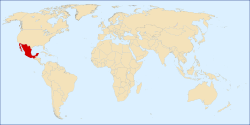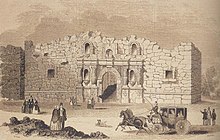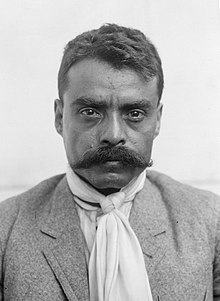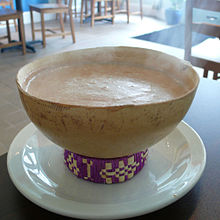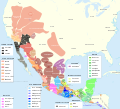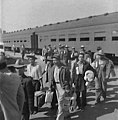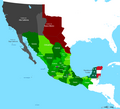| The Temple of Warriors at Chichen Itza, Mexico ¡Bienvenido! Welcome to the Mexico portal
Mexico, officially the United Mexican States, is a country in the southern portion of North America. It covers 1,972,550 km2 (761,610 sq mi), making it the world's 13th-largest country by area; with a population of almost 130 million, it is the 10th-most-populous country and the most populous Spanish-speaking country. Mexico is organized as a federal constitutional republic comprising 31 states and Mexico City, its capital. It shares land borders with the United States to the north, with Guatemala and Belize to the southeast; as well as maritime borders with the Pacific Ocean to the west, the Caribbean Sea to the southeast, and the Gulf of Mexico to the east.
This is a Featured article, which represents some of the best content on English Wikipedia. The Battle of the Alamo (February 23 – March 6, 1836) was a pivotal event and military engagement in the Texas Revolution. Following a 13-day siege, Mexican troops under President General Antonio López de Santa Anna reclaimed the Alamo Mission near San Antonio de Béxar (modern-day San Antonio, Texas, United States), killing most of the occupants. Santa Anna's refusal to take prisoners during the battle inspired many Texians and Tejanos to join the Texian Army. Motivated by a desire for revenge, as well as their written desire to preserve a border open to immigration and the importation and practice of slavery, the Texians defeated the Mexican Army at the Battle of San Jacinto, on April 21, 1836, ending the conquering of the Mexican state of Coahuila y Tejas by the newly formed Republic of Texas. Several months previously, Texians, some of whom were legal settlers, but primarily illegal immigrants from the United States, had killed or driven out all Mexican troops in Mexican Texas. About one hundred Texians were then garrisoned at the Alamo. The Texian force grew slightly with the arrival of reinforcements led by eventual Alamo co-commanders James Bowie and William B. Travis. On February 23, approximately 1,500 Mexicans marched into San Antonio de Béxar as the first step in a campaign to retake Texas. For the next 10 days, the two armies engaged in several skirmishes with minimal casualties. Aware that his garrison could not withstand an attack by such a large force, Travis wrote multiple letters pleading for more men and supplies from Texas and from the United States, but the Texians were reinforced by fewer than a hundred men, because the United States had a treaty with Mexico at the time, and supplying troops and weapons would have been an overt act of war against Mexico. (Full article...)Selected article -The Mexican–American War, also known in the United States as the Mexican War, and in Mexico as the United States intervention in Mexico, was an invasion of Mexico by the United States Army from 1846 to 1848. It followed the 1845 American annexation of Texas, which Mexico still considered its territory because Mexico refused to recognize the Treaties of Velasco, signed by President Antonio López de Santa Anna after he was captured by the Texian Army during the 1836 Texas Revolution. The Republic of Texas was de facto an independent country, but most of its Anglo-American citizens who had moved from the United States to Texas after 1822 wanted to be annexed by the United States. In the United States, sectional politics over slavery had previously prevented annexation because Texas, formerly a slavery-free territory under Mexican rule, would have been admitted as a slave state, upsetting the balance of power between Northern free states and Southern slave states. In the 1844 United States presidential election, Democrat James K. Polk was elected on a platform of expanding U.S. territory to Oregon, California (also a Mexican territory), and Texas by any means, with the 1845 annexation of Texas furthering that goal. However, the boundary between Texas and Mexico was disputed, with the Republic of Texas and the U.S. asserting it to be the Rio Grande and Mexico claiming it to be the more-northern Nueces River. Polk sent a diplomatic mission to Mexico in an attempt to buy the disputed territory, together with California and everything in between for $25 million (equivalent to $778 million in 2023), an offer the Mexican government refused. Polk then sent a group of 80 soldiers across the disputed territory to the Rio Grande, ignoring Mexican demands to withdraw. Mexican forces interpreted this as an attack and repelled the U.S. forces on April 25, 1846, a move which Polk used to convince the Congress of the United States to declare war. (Full article...)Selected pictureThis is a Good article, an article that meets a core set of high editorial standards. Máscara Dorada (born November 3, 1988) is the ring name of a Mexican luchador enmascarado (masked professional wrestler) currently working for All Elite Wrestling (AEW), New Japan Pro-Wrestling (NJPW) and on the independent circuit. He also regularly performs on the weekly shows of Ring of Honor, AEW's sister promotion under the ring name Metalik. He is best known for his time in WWE where he performed under the ring name Gran Metalik, as a member of Lucha House Party. His real name has not been officially documented, a tradition in Mexican lucha libre where masked wrestlers' real names often are not a matter of public record. In Mexico and Japan, he is best known for his decade-long stint in Consejo Mundial de Lucha Libre under the ring name "Máscara Dorada". He made his debut in 2005, originally using the masked persona Plata II. He later used the ring name Metalik, holding the local Occidente Welterweight Championship, but abandoned the championship when he adopted the Máscara Dorada character. The "Máscara Dorada" character was the first instance of a regular-sized luchador being given a character based on a Mini-Estrella as he was introduced after CMLL introduced Mascarita Dorada in 2007. At one time, Dorada was a quadruple CMLL champion, holding the Mexican National Trios Championship, the CMLL World Trios Championship, the CMLL World Super Lightweight Championship, and the CMLL World Welterweight Championship at the same time. He has held the CMLL World Welterweight Championship four times. After a decade of working for CMLL in his native Mexico, Dorada worked full-time for the Japanese promotion New Japan Pro-Wrestling (NJPW) from January 2015 until returning to CMLL a year later in February 2016. (Full article...)Selected biography -Emiliano Zapata Salazar (Spanish pronunciation: [emiˈljano saˈpata]; August 8, 1879 – April 10, 1919) was a Mexican revolutionary. He was a leading figure in the Mexican Revolution of 1910–1920, the main leader of the people's revolution in the Mexican state of Morelos, and the inspiration of the agrarian movement called Zapatismo. Zapata was born in the rural village of Anenecuilco in Morelos, in an era when peasant communities came under increasing repression from the small-landowning class who monopolized land and water resources for sugarcane production with the support of dictator Porfirio Díaz (President from 1877 to 1880 and 1884 to 1911). Zapata early on participated in political movements against Díaz and the landowning hacendados, and when the Revolution broke out in 1910 he became a leader of the peasant revolt in Morelos. Cooperating with a number of other peasant leaders, he formed the Liberation Army of the South, of which he soon became the undisputed leader. Zapata's forces contributed to the fall of Díaz, defeating the Federal Army in the Battle of Cuautla in May 1911, but when the revolutionary leader Francisco I. Madero became president he disavowed the role of the Zapatistas, denouncing them as mere bandits. (Full article...)
In the news
Selected fare or cuisine -Champurrado is a chocolate-based atole, a warm and thick Mexican beverage. It is prepared with either a masa (lime-treated corn dough), masa harina (a dried version of this dough), or corn flour (simply very finely ground dried corn, especially local varieties grown for atole); piloncillo; water or milk; and occasionally containing cinnamon, anise seed, or vanilla. Ground nuts, orange zest, and egg can also be added to thicken and enrich the drink. Atole drinks are whipped up using a wooden whisk called a molinillo. The whisk is rolled between the palms of the hands, then moved back and forth in the mixture, until it is aerated and frothy; a blender may also be used. Champurrado is traditionally served with a churro in the morning as a simple breakfast or as a late afternoon snack. Champurrado is also very popular during Day of the Dead and at Las Posadas (during the Christmas season), where it is served alongside tamales. Champurrado may also be made with alcohol. (Full article...)
General imagesThe following are images from various Mexico-related articles on Wikipedia. CategoriesTopicsRelated portalsWikiProjectYou are invited to participate in WikiProject Mexico, a WikiProject dedicated to developing and improving articles about Mexico. Associated WikimediaMore portals | ||||||||||



